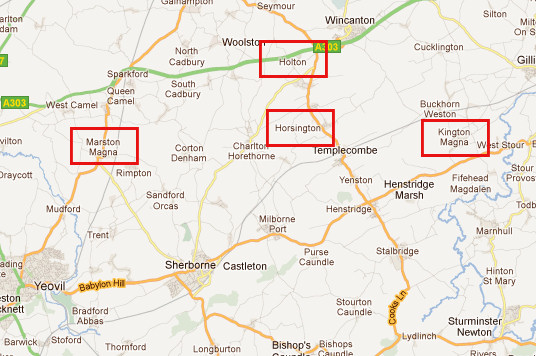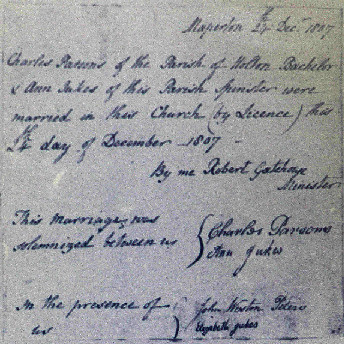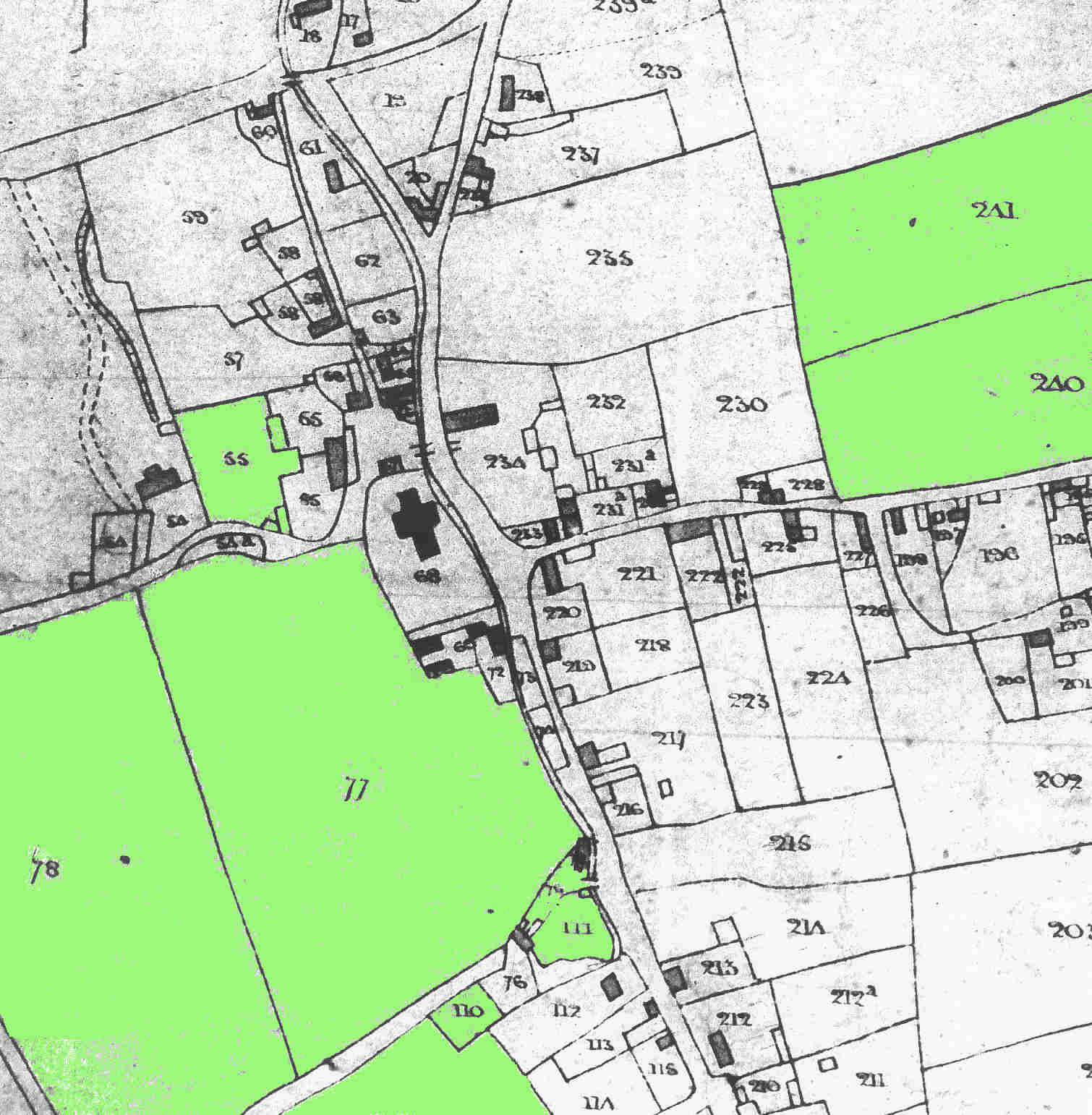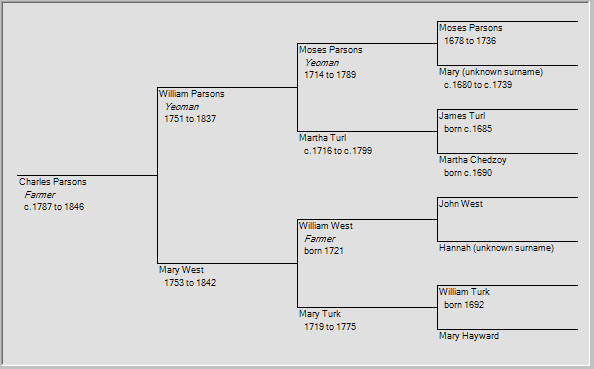 Sidney Alfred Parsons and his Ancestors
Sidney Alfred Parsons and his AncestorsCharles Parsons (1787 to 1846)
Charles Parsons was a great-grandfather of Sidney Parsons. His son Edward was Sidney’s grandfather.
Charles lived for most of his life in Marston Magna, a village in south west England, in the heart of the ancient Kingdom of Wessex. Less than three miles away is Cadbury Castle, said by some to be the original Camelot of King Arthur.

Charles’ ancestors had farmed on the Somerset/Dorset border between Yeovil, Sherborne, Gillingham and Wincanton for centuries.
His earliest known ancestor to bear the Parsons name was Richard Parsons who lived in Kington Magna in Dorset where he died in 1713.
Another Richard Parsons, possibly a relative, had set up a weaving and flax dressing business in Wincanton in 1646, just after the Civil War, and after his wife died in 1680 he moved to Kington Magna.
Charles Parsons’ parents, William Parsons and Mary West, had moved from Kington Magna to Horsington and then, in the late 1780s, to Holton where they lived for many years. But by 1836, when William died, he was living on the farm which he had inherited in Kington Magna.
Charles was born in 1785. He was part of a large family but several of his brothers and sisters did not survive to become adults. Charles was the third son and he would have been quite young when his parents moved to Holton.
Charles Parsons got married on Christmas Eve 1807 at the Church of Saints Peter and Paul in the parish of Maperton.
Maperton, which adjoins Holton immediately to its west, was the home parish of his bride Ann Jukes.

Hatherleigh, where Ann lived, was at that time a part of the parish of Maperton but later became part of Holton. She had been born between Bourton and Silton, two small villages a few miles further east, near Gillingham in Dorset (Silton is just visible in the top right corner of the map above) but her father had died when she was about ten years old and had she had moved to Hatherleigh Farm, to live with relatives. More than 60 years later Charles and Ann’s son Charles would live with his family at Hatherleigh Farm for a few years.
Maperton was also the home of John Weston Peters, a witness at the wedding, who was a wealthy friend of the Parsons family. John was associated with Lord Portman who owned a large amount of land in the West Country and London. John’s sister Jane Peters had married Charles’ brother George and one of their sons, William Parsons, eventually received a large legacy from the very extensive Weston Peters estate but it was a condition of the will that he assumed the surname Peters. In order to comply he changed his name to William Parsons Peters.
The other witness at the wedding was Elizabeth Jukes who was either Ann’s mother Elizabeth, or Elizabeth the wife of Richard Jukes, with whom she had been living.
This marriage entry in the parish register is unusually large and carefully laid out which reflected the standing of the Parsons and Jukes families in the local community as did the presence of the wealthy and distinguished John Weston Peters.
Charles and Ann’s first child was a boy who was born in Hatherleigh just over a year after they married. They called him Edward and he would eventually become a grandfather of Sidney Parsons. Edward was not baptised in the parish of Maperton but in nearby Wincanton. He was given his mother’s maiden name ‘Jukes’ as a second christian name, a tradition which he continued when he gave his own first son John the middle name ‘Taylor’.
During the early part of their life together Charles and Ann moved several times. Their second child, another boy, was baptised in Holwell, near Bruton, some miles to the north of Hatherleigh. They named him Charles. Richard, their third child, was baptised in Nether Compton which is in Dorset, south of Marston Magna. Richard was, unusually, baptised twice and on the second occasion he was, like his brother Edward, given the middle name ‘Jukes’. Ann might have decided to do so in honour of her relative Richard Jukes who had recently been killed by a bull.
By the early 1820s Charles and Ann had settled in Marston Magna where they stayed for the rest of their married lives.
Charles Parsons was a moderately wealthy man. He and his family lived in Garston Lane, behind the church. His garden, orchard and offices were situated there. The village had a pair of shops, a grocer’s and a butcher’s, both of which Charles owned. His property in the village centre formed complex which included his slaughter house, stables and piggeries. Charles farmed a considerable amount of land in and around the village, most or all of which he leased.
In 1837 Charles’ father died and he inherited two houses in Holton, both of which were occupied and gave him rental income. And in 1842, when the residue of his father’s estate was finally distributed, he received a legacy of £100 which was a substantial sum at that time.
Below is part of the 1840 Tithe Map for the Parish of Marston Magna. It shows the centre of the village.
The areas coloured green were farmed or occupied by Charles Parsons. His house, yard, garden and offices are shown near the village centre in
the plot numbered 55.

Charles also owned several large fields outside the village centre. The complete list of his holdings within the boundaries of the
parish of Marston Magna in 1840 is:
• Towns end - pasture
• Wesby Brook - arable
• House, yard, garden and offices
• Court Garden - pasture
• Garston - pasture
• Snooks Mead - pasture
• Garden yard and buildings
• Shreikles - arable
• Chilverland - orchard
• Chilverland - pasture
• Hill Head - pasture
• Hill Head three acres - arable
• Hill Head eight acres - arable
• Hill Head eight acres - arable
• Lambrook - pasture
• Handle - arable
• Handle Orchard - orchard
• Great Wooller - arable

Charles’ relative wealth entitled him to vote in parliamentary elections and he appeared in the Poll Book for Marston Magna.
As a prominent local farmer, Charles had civic responsibilities. He contributed to the Parish’s poor rate and was eligible for
jury service. He was also for many years a Churchwarden and Overseer of the Poor.
The incident reported in the newspaper cutting on the right, which comes from the September 9th 1843 edition of the Sherborne Mercury,
shows that Charles was also responsible for the highways in Marston Magna and that such responsibilities carried risks.
In 1835 Charles, with the other main farmers of the parish, publicly pledged to support the Queen Camel fairs by attending and providing stock.
They placed newspaper advertisements to that effect.
Charles Parsons died on the 29th of August 1846 of gastroenteritis and typhus. He had been ill for three weeks. James Biddiscombe, who was a friend and neighbour, registered the death.
Charles appointed his nephew Charles Peters Parsons and his second son Charles as his trustees. Charles Peters Parsons was a son of Charles’ brother George who lived in Charlton Horethorne. Under the terms of the will Charles’ widow Ann continued to live in the farm house for some years but eventually she went to live with her daughter Elizabeth in Yatton, near Bristol. She died there in December 1858 and then most of Charles’ property, including the house, passed to his second son, Charles. He left money to all of his children except Edward, his eldest son, who received no legacy. It is tempting to speculate why but we will probably never know the reason.
Click here to see a transcription of Charles Parsons’ will.
At the time of writing, Charles and Ann’s tombstone was still standing in the church yard of St. Mary’s in Marston Magna. The inscription reads:
“Sacred to the memory of Charles Parsons who Died August 29 1846 aged 59 years
Also of William his son who Died April ..... aged 17 years
Also of Ann widow of the above Charles Parsons who Died December 21 1858 aged 73 years”
Children of Charles Parsons and his wife Anne (née Jukes)

Charles and Ann’s children and their spouses are shown in the chart to the left. Two of the boys,
Edward and Richard, were given Ann’s maiden name
Jukes as their middle names.
Edward’s third son, John, who spent most of his life as a publican in Southampton, was the father of Sidney Parsons and a great-grandfather of the present author.
More information about Ann and Charles’ children, can be found by following the link to Charles Parsons and Ann Jukes’ Children.
Ancestors of Charles Parsons

Parents
Father — William Parsons, a farmer and inn-keeper from Holton in Somerset
Mother — Mary West, the daughter of a butcher from East Stour in Dorset
Grandparents
Grandfather — Moses Parsons the younger of Kington Magna in Dorset
Grandmother — Martha Turl who was born in Taunton in Somerset but married Moses in Shaftesbury
Grandfather — William West, a farmer from Stalbridge in Dorset but who lived for most of his life in Stowell in Somerset
Grandmother — Mary Turk who also came from Stalbridge
Great-grandparents
Great-grandfather — Moses Parsons the elder of Kington Magna
Great-grandmother — Mary his wife, whose maiden name is not known
Great-grandfather — James Turl, who came from Taunton in Somerset
Great-grandmother — Martha Chedzoy, his wife, who also came from Taunton
Great-grandfather — John West, from Stalbridge in Dorset
Great-grandmother — Hannah his wife, whose maiden name is not known
Great-grandfather — William Turk, who was baptised in Stalbridge in March 1692
Great-grandmother — Mary Hayward, whom he married in April 1718
Return to Sidney Parsons’ Ancestors
You are free to make use of the information in these web pages in any way that you wish but please be aware that the author, Mike Parsons, is unable to accept respsonsibility for any errors or omissions.
Mike can be contacted at parsonspublic@gmail.com
The information in these web pages comes from a number of sources including: Hampshire County Records Office, Somerset Heritage Centre; Dorset County Records Office; Southampton City Archives; the General Register Office; several on-line newspaper archives; several on-line transcriptions of Parish Register Entries; and several on-line indexes of births, marriages and deaths. The research has also been guided at times by the published work of others, both on-line and in the form of printed books, and by information from personal correspondence with other researchers, for all of which thanks are given. However, all of the information in these web pages has been independently verified by the author from original sources, facimile copies, or, in the case of a few parish register entries, transcriptions published by on-line genealogy sites. The author is aware that some other researchers have in some cases drawn different conclusions and have published information which is at variance from that shown in these web pages.
Copyright © 2013 Mike Parsons. All rights reserved.